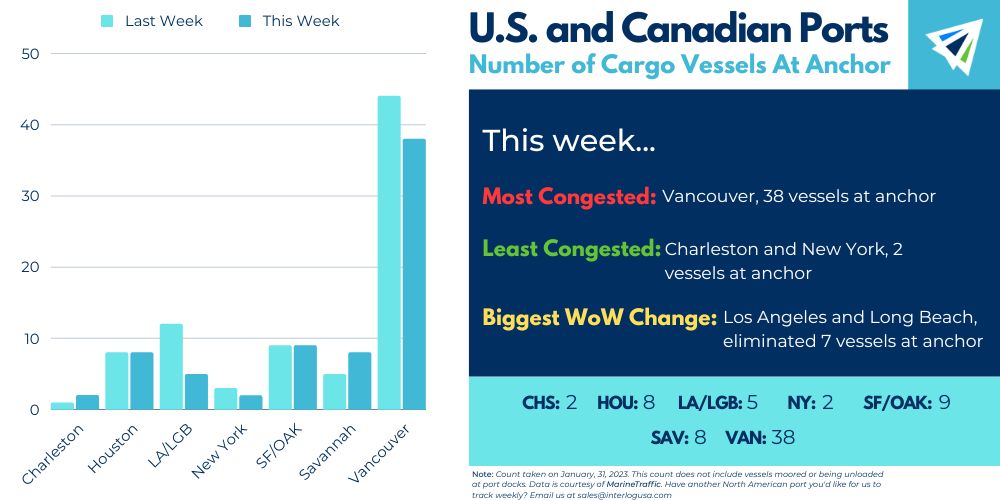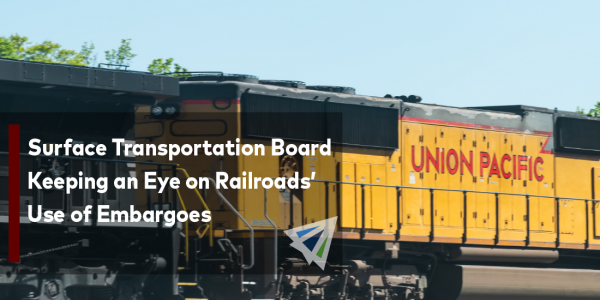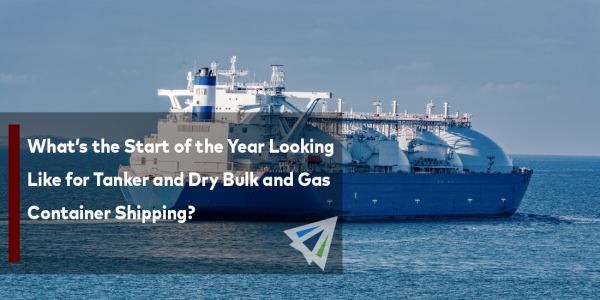Competitive Edge
February 1st, 2023

Takeaways
• U.S. West Coast: Congestion is minimal, but so are freight volumes. While there is low demand moving through all US coasts, the WC has been at the forefront. The WC’s import share continues to deteriorate as labor contract negotiations stall.
• U.S. Gulf Coast: Houston stays level week-over-week. The Gulf Coast’s dwell fee program is set to go into effect today, February 1. The Port of Houston will charge $45 per unit per day to cargo owners if a container lingers more than eight days.
• U.S. East Coast: Congestion is also minimal on the EC. Given its stable track record over the last few weeks, we can safely assume the EC will be consistently low with its ship counts.
IMPORT: Asia to North America (TPEB)
Recent Developments:
• Chinese New Year began January 22. Ports will return to normal operations and factories will reopen February 5.
• West Coast contract negotiations between the International Longshore and Warehouse Union (ILWU) and Pacific Maritime Association (PMA) remain active. The existing labor contract between the two parties expired July 1. Recent job actions from dockworkers have reportedly disrupted cargo flow frustrating WC port officials. Dockworkers are “limiting the level of disruption” to avoid attracting media and government attention. Read more about this in our freight news section below.
Rates: No CNY rate hikes reported. Rates to the WC leveled before CNY. EC and GC rates are still seeing decreases.
Space: Space is open.
Capacity: Capacity is open. However, blank sailings are now typical as a means from carriers to shed excess market capacity and restore scheduling. That said, we cannot rule out a possible capacity crunch as a bulk of CNY blank sailings are expected over the next couple of weeks.
Equipment: Lower inbound volumes have brought relief to equipment deficits and congestion for both inland and coastal ports.
TIPS:
• Book at least two weeks prior to the ready date.
• Coordinate with providers as soon as possible on post-CNY bookings.
• Expect blank sailings to carry on through Q1 2023.
IMPORT: Europe to North America (TAWB)
Rates: With capacity increasing and demand dropping, rates remain falling for this trade. However, they are still almost triple what they were pre-pandemic.
Space: Space to both U.S. coasts have opened up as U.S. congestion is minimal.
Capacity: Larger vessels have entered the market boosting the trade lane’s capacity. The 2M Alliance (Maersk and MSC) are announcing additions of even more market capacity.
Equipment: Availability has improved on both sides of the trade.
TIPS:
• Book at least three weeks prior to ready date.
• Even as market conditions become more fair, premium services (i.e., no-roll options and improved cargo reliability) should still be considered.
EXPORT: North America to Asia
Rates: Rates are stable if not slightly decreasing. Though, they are not plummeting in this market like its inbound counterpart (Asia to North America).
Capacity: Capacity is widely available for all services. Aside from possible blank sailings in February, no considerable changes to this market’s capacity in the near future.
Equipment: Most inland and coastal ports have balanced out their equipment availability. No outstanding challenges to U.S. availability to report as of now.
TIPS:
• Book at least three weeks prior to the time of departure.
• While not as frequent as its inbound counterpart, remain in close contact with your providers to be aware of any potential developments, like blank sailings.
• Shippers with high volume projects should take advantage of carrier receptiveness to take on these opportunities. Space is wide open with a high acceptance rate.
InterlogUSA Proudly Presents...Freight FM Ep. 5: Discussing the China Trade Lane
In our latest episode, InterlogUSA’s Rachel and Madison discuss the China trade lane and what importers can expect after Chinese New Year.
If you are a China importer, you’ll want to check this episode out!
“Freight FM” features short-form video interviews with InterlogUSA’s industry experts offering insights into breaking news, market trends, our company’s history, and more!
Did You Know: Update on Union Pacific Railroad Outage
Bridges have been repaired at Santa Rosa, New Mexico and were complete last Friday.
In a statement, UP reminds customers with rail shipments moving between Dalhart and El Paso, Texas that they still may experience delays for the next 24-48 hours as UP works on the backlog of rail shipments due to the repairs.
Freight News
Contract Talks Continue Out on the U.S. West Coast
A quick refresher:
Last May, contract negotiations began between the International Longshore & Warehouse Union (ILWU) and Pacific Maritime Association. Their current contract expired on July 1st, 2022. As of now, no resolution/contract has been made. Both of these groups play a vital role in keeping the ports on the USWC running.
What’s currently happening:
Well, as to be expected, contract talks are still continuing, perhaps lasting longer than many in the shipping industry would like. Recently, frustration has been brewing for those stakeholders due to recent job actions by dockworkers, impacting the flow of cargo. Unit breaks and equipment checks have been two actions that have caused some disruptions.
As the JOC points out, some retailers say they will continue to shift as much discretionary cargo as they can away from the USWC until a new labor contract is in place.
We will continue to post updates when more developments regarding these contract talks occur.
Class I Railroads Detail Plans to Address Quality-of-Life Issues for Their Employees
Back in the beginning of the pandemic, many railroads who furloughed thousands of employees, struggled to hire them back, largely due to quality-of-life issues.
The eastern railroads said in a fourth quarter earnings call that furloughs doing the pandemic were more costly in the long run because many of the workers did not recent, which made the railroads have to recruit/hire/train new employees which can take time.
Those quality-of-life issues were at the forefront of contract negotiations last summer between the unions and railroads – with some union members unhappy with the lack of
Now, the U.S. Class I railroads are seeking to address quality-of-life issues for their employees. Including pilot programs to help reduce the number of on-call jobs and reducing furloughs of front-line employees during economic downturns, the JOC notes.
During the summer last year, the Presidential Executive Board recommended that several of the quality-of-life issues, like sick days, should be negotiated on the local level and not nationally. Which is where (locally) the railroads are planning on addressing those matters, flexible jobs and more predictable work schedules.
Watch Our January Webinar!
We discussed the impact of zero COVID policy suspension in mainland China before the Chinese New Year holiday, CNY impacts, carriers’ blank sailings before/after CNY timeframe, and the 2023 China Ocean Market Outlook.
Sign Up for Next Month's Webinar
Our next webinar will be on Wednesday, February 15th!
Keep an eye out for an announcement on topics we’ll be discussing next webinar and potential special guests!
We would like to hear from you. If you have any questions or topics you would like our experts to discuss in future webinars, please let us know!
Interlog  Insights
Insights
In last week’s newsletter, our experts detailed our final predictions for the month of January, what container flow at U.S. ports currently looks like, and why shippers should not rule out air freight.
With a new month comes new predictions and insights. Stay tuned for our first February issue coming this Friday!
Sign up for our
industry answers
Our team works to provide valuable, unique, and relevant content to assist you in finding solutions. Sign up now.

